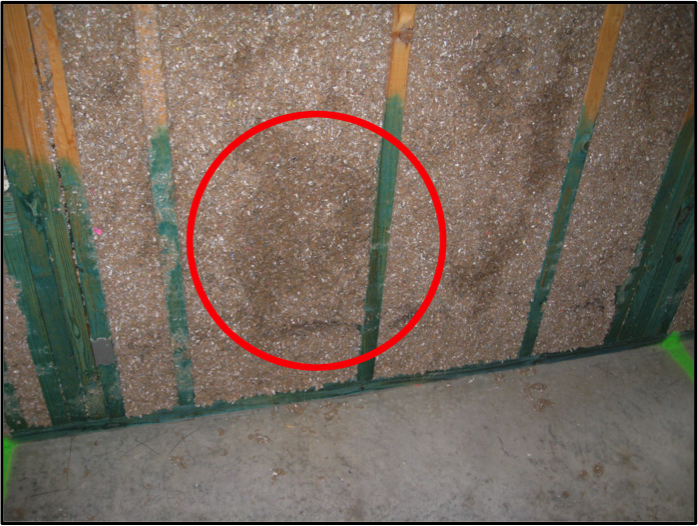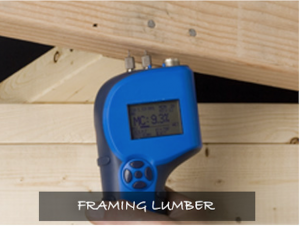Scope
Do not install drywall if framing and/or insulation materials are damp.
- Inspect framing, sheathing, and insulation for dampness before installing drywall and other wall materials that would limit the framing and insulation’s ability to dry out.
- Test the framing with a moisture meter to ensure the lumber moisture content is ≤18%, as recommended by ENERGY STAR.
- If damp, allow materials to air dry or dry with fans before enclosing the walls.
- Follow the manufacturer’s specifications when installing wet-applied insulation products to ensure an adequate amount of drying time.
See the Compliance Tab for links to related codes and standards and voluntary federal energy-efficiency program requirements.
Description
Moisture that gets trapped inside a home during construction can lead to mold and mildew (and associated indoor air quality issues) as well as rotting and failure of structural elements. There are several ways moisture can get into buildings under construction. Lumber and materials can arrive at the site wet, they can get wet due to rain or snowfall during construction, or they can sit on wet ground unprotected. These materials must be allowed to dry out before the drywall is installed. The most common wet building material is dimensional lumber used for framing. This material usually arrives at the jobsite early and will be exposed to the elements longer than other building materials. See the guide No Visible Signs of Water Damage or Mold for ways to protect materials from water damage at the job site. There are also many construction materials, like cement, concrete, wet-installed insulation, and fluid-applied flashing, that are installed wet and must be allowed to cure and dry before the house is closed in. Builders should follow manufacturer's instructions for drying times and allow plenty of time in the construction schedule to accommodate those drying times. If interior walls are enclosed (e.g., with drywall) when framing materials and insulation are wet, the trapped moisture can lead to problems for the home. Therefore, it is essential to do the following before enclosing the interior walls:
- Test the moisture content of building materials and ensure that lumber does not exceed 18% moisture content.
- Follow the manufacturer’s drying specifications for wet-applied insulation products.

Measuring Moisture Content of Framing Materials
If framing materials appear wet, you must test them using a moisture meter. Moisture meters will give you a reliable benchmark to evaluate whether or not the materials can be safely installed in the home.
To test the moisture content of wood, you can use a resistance meter. A resistance meter measures the moisture by sending a small electrical charge through two probes inserted into the lumber. If the wood is wet, the charge will pass easily between the probes; dry wood offers greater resistance and less charge will pass (Curkeet 2011). Some moisture meters have additional features that allow the units to be calibrated for different kinds of wood, but usually at a higher cost. In general you can expect to spend between $500 and $650 on a moisture meter that will be suitable for residential construction (PNNL 2012).
How to Use a Moisture Meter (Curkeet 2011):
- Insert the probes at least 1/4 inch into the wood to get an accurate measurement.
- Insert the probes parallel with the grain of the wood.
- Do not try to test wood on the ends; this will not give an accurate measurement.
- Test in multiple locations along the lumber to get an accurate assessment. The meter only measures the moisture content between the probes. Although moisture can saturate an entire piece of lumber, it also can only impact a small section; therefore, you should test multiple areas of the wood to ensure the entire piece is dry enough to install and enclose.
- If the material has a high moisture content, allow it to dry until it is under the required moisture threshold. Use dehumidifiers, fans, and gentle heat to shorten the drying time and lessen the impact on the construction schedule (EPA 2013).

Follow Manufacturer’s Specifications When Drying Wet-Applied Insulation Products
Some insulation products, such as fiberglass batts, are supposed to be dry at all times. However, other products, such as open cell and closed cell spray foam insulations, are wet applied. It is critical to ensure these wet-applied products are fully dried (and cured, if required) before enclosing them. Follow this overall guidance:
- Apply insulation per manufacturer’s directions.
- Allow insulation to dry and/or cure according to the manufacturer’s specifications. Although this will depend on the type of insulation used, in general allow as much access to airflow as possible for drying. If recommended, a fan can help speed drying times. However, this can impact any curing that may need to occur, so be sure to check with the manufacturer first.
Success
It is critical to ensure the materials in the wall cavity are dry before being enclosed. When in doubt, use a moisture meter to determine exactly what percentage of moisture is in the material. Also, be sure that any wet-applied insulation is fully cured so you do not trap moisture in the wall assembly.
Climate
No climate-specific information applies.
Training
Compliance
Retrofit
Follow the guidance provided in the Description tab regarding testing the moisture content of lumber and other construction materials before installing them in existing homes as part of a remodel or addition.
For more information, see the U.S. Department of Energy’s Standard Work Specifications regarding wood moisture.
More
More Info.
Access to some references may require purchase from the publisher. While we continually update our database, links may have changed since posting. Please contact our webmaster if you find broken links.
The following authors and organizations contributed to the content in this Guide.
Sales
Water Managed Building Materials = Interior Moisture Control Materials

Wood, drywall, and other building materials are susceptible to moisture damage in areas exposed to water such as bathrooms, sinks, and even entry areas. Water-resistant materials should be used in these areas. Tile and stone are water resistant when installed with cement-based underlayment and moisture barriers. Carpet should not be used in damp areas. Fiberglass-based wall board is an option in potentially damp areas such as basements.


